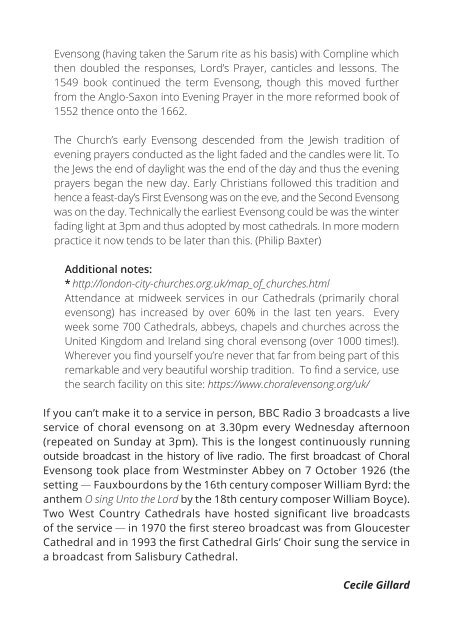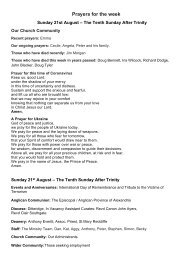You also want an ePaper? Increase the reach of your titles
YUMPU automatically turns print PDFs into web optimized ePapers that Google loves.
Evensong (having taken the Sarum rite as his basis) with Compline which<br />
then doubled the responses, Lord’s Prayer, canticles and lessons. The<br />
1549 book continued the term Evensong, though this moved further<br />
from the Anglo-Saxon into Evening Prayer in the more reformed book of<br />
1552 thence onto the 1662.<br />
The <strong>Church</strong>’s early Evensong descended from the Jewish tradition of<br />
evening prayers conducted as the light faded and the candles were lit. To<br />
the Jews the end of daylight was the end of the day and thus the evening<br />
prayers began the new day. Early Christians followed this tradition and<br />
hence a feast-day’s First Evensong was on the eve, and the Second Evensong<br />
was on the day. Technically the earliest Evensong could be was the winter<br />
fading light at 3pm and thus adopted by most cathedrals. In more modern<br />
practice it now tends to be later than this. (Philip Baxter)<br />
Additional notes:<br />
* http://london-city-churches.org.uk/map_of_churches.html<br />
Attendance at midweek services in our Cathedrals (primarily choral<br />
evensong) has increased by over 60% in the last ten years. Every<br />
week some 700 Cathedrals, abbeys, chapels and churches across the<br />
United Kingdom and Ireland sing choral evensong (over 1000 times!).<br />
Wherever you find yourself you’re never that far from being part of this<br />
remarkable and very beautiful worship tradition. To find a service, use<br />
the search facility on this site: https://www.choralevensong.org/uk/<br />
If you can’t make it to a service in person, BBC Radio 3 broadcasts a live<br />
service of choral evensong on at 3.30pm every Wednesday afternoon<br />
(repeated on Sunday at 3pm). This is the longest continuously running<br />
outside broadcast in the history of live radio. The first broadcast of Choral<br />
Evensong took place from Westminster Abbey on 7 October 1926 (the<br />
setting — Fauxbourdons by the 16th century composer William Byrd: the<br />
anthem O sing Unto the Lord by the 18th century composer William Boyce).<br />
Two West Country Cathedrals have hosted significant live broadcasts<br />
of the service — in 1970 the first stereo broadcast was from Gloucester<br />
Cathedral and in 1993 the first Cathedral Girls’ Choir sung the service in<br />
a broadcast from Salisbury Cathedral.<br />
Cecile Gillard<br />
THE STORIES BEHIND SOME OF OUR CAROLS — LESTER CLEMENTS<br />
Says Lester: Over the Christmas period, carols will be sung up and<br />
down the land, but did you know some of the stories behind them...<br />
Good King Wenceslas<br />
Wenceslaus I, Duke of Bohemia, born Prague<br />
c.905, died <strong>St</strong>ará Boleslav 28 September 935.<br />
Saint & martyr: Catholic and Eastern Orthodox<br />
churches; feast 28 September. <strong>St</strong> Wenceslas<br />
Flaming Eagle (above) became the Coat of<br />
Arms of the ruling Czech Przemyslid Dynasty<br />
WENCESLAUS (Wenceslas) was<br />
the son of Vratislaus, Duke of<br />
Bohemia of the Przemyslid dynasty.<br />
His grandfather had been converted<br />
to Christianity; his mother, Drahomira,<br />
the daughter of a pagan tribal chief,<br />
was baptised at the time of her marriage.<br />
His paternal grandmother,<br />
Ludmila of Bohemia, oversaw his<br />
education and at an early age he<br />
was sent to college at Budec. In 921<br />
Wenceslas’s father died and Ludmila<br />
became regent, but Drahomira was<br />
jealous of Ludmila’s influence over<br />
Wenceslas so she had her murdered<br />
(possibly strangled with her veil);<br />
Ludmilla was buried at the church of<br />
<strong>St</strong> Michael of Tetin but her remains<br />
were later removed, probably by<br />
Wenceslas, to <strong>St</strong> George’s church in<br />
Prague, which had been built by his<br />
father. Drahomira assumed the role<br />
of regent and immediately initiated<br />
measures against the Christians but<br />
when Wenceslas came of age (c.925)<br />
he took control of the government<br />
and exiled his mother. To prevent<br />
any disputes, he divided the country<br />
between himself and his younger<br />
brother, Boleslav, to whom he gave<br />
a large share. He brought in German<br />
priests and favoured the Latin rite in<br />
churches over the old Slavic rite (seldom<br />
used for want of priests), and<br />
founded a rotunda consecrated to <strong>St</strong><br />
Vitus at Prague Castle (today <strong>St</strong> Vitus<br />
cathedral). However, in 935 Boleslav<br />
and nobles plotted to kill Wenceslas,<br />
and invited him to the feast of Saints<br />
Cosmas and Damian where three<br />
nobles stabbed to him to death and<br />
Boleslav ran him through with a lance.<br />
Wenceslas was considered both<br />
martyr and saint immediately after<br />
his death, and a monarch whose<br />
power stemmed from his great piety<br />
as well as his princely vigour.The<br />
chronicler Cosmas of Prague, writing<br />
around the year 1119, states:<br />
“But his deed I think you know better<br />
that I could tell you; for, as is read in


















